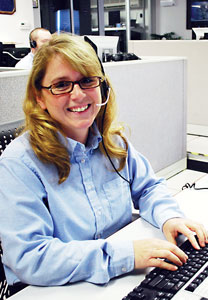
|
|
Vector Security is one of three central stations that has deployed the ASAP to PSAP program. CSAA is working on getting more central stations live in 2013. PHOTO COURTESY OF VECTOR SECURITY |
The ASAP to PSAP program has cleared the hurdle of being able to accept additional central stations, and is now focused on recruiting the 6,500 PSAPs across the country.
Government budget constraints, and alarm company infrastructure and testing requirements have made a nationwide rollout of the Automated Secure Alarm Protocol (ASAP) to Public Safety Answering Points (PSAP) program slower than many had initially hoped. However, significant developments have been made over the past year, and the program stands in good shape to save more cities and alarm companies significant resources, time and money.
The Central Station Alarm Association’s ASAP to PSAP program delivers alarm notification information from central stations to PSAPs by way of computer rather than phone. Transmitting the data electronically not only speeds up alarm notification delivery, but also reduces the number of phone calls and processing time, and eliminates errors or miscommunication between central station operators and 911 operators, says Pam Petrow, co-chair of the CSAA’s ASAP Steering Committee.
“The pre-authentication of the address and correct PSAP is invaluable. ASAP allows the address to be compared against the PSAP’s database before an alarm activation, so you know that when an emergency occurs, you are calling the correct 911 center,” Petrow explains. In addition, the accuracy of the transmitted information and the elimination of spending time waiting on hold or communicating information to the PSAP operator are additional benefits of an automated alarm protocol, Petrow adds.
After three successful deployments of the program in Houston, Richmond, Va., and York County, Va., with three participating central stations (Vector Security, UCC and Monitronics), two more cities are operating live — Washington, D.C., and Tempe, Ariz. — and a third is on track to go live by the end of 2012 — James City County in Virginia.
“The really big news, however, is that we’ve cleared the hurdle of being able to accept additional central stations,” reports Ed Bonifas, past CSAA president and co-chair of the ASAP Committee. With the financial backing of 100 charter members, the CSAA has finalized implementation of its message broker, which functions as a gatekeeper to the network distributing the data, and can now allow the organization to open up ASAP integration beyond the existing pilot central stations and PSAPs.
“This has created a lot of momentum for charter members and for PSAPs that have been waiting for this step to be done,” Petrow explains. “We still have some enhancements we will add in the next generation, but [there are] no limits at present on throughput.” Now that this step has been completed, CSAA is collecting applications and agreements from alarm companies with accounts in the deployed cities that have automation tested or are ready to be tested.
By January 2013, CSAA hopes to have some additional alarm companies connected to the automation program in existing cities, according to Bonifas. Getting charter members, national alarm companies and independent alarm companies with accounts in existing cities connected to the program will also be the priority for the rest of 2013, he adds.
The next focus will be on recruiting the 6,500 PSAPs across the country — or, in other words, expanding the program to additional cities and counties. PSAPs must upgrade their computer-aided dispatch (CAD) software to be able to handle the automated data from central stations. The ASAP Outreach Committee has spent a significant portion of the past year putting together materials and information needed to educate PSAPs on the ASAP program. Through surveys with charter members and other research, the committee is currently identifying the PSAP markets where it makes the most sense to deploy first, based on alarm traffic and number of accounts. The committee also wants to work with any PSAP that implements a new CAD upgrade or expresses interest in the program as well, despite its size.
While the system is ready to go, because of budget constraints and other priorities, many PSAPs may not have an upgrade on their short list and smaller central stations may not have the automation or procedures in place either, which will make nationwide deployment of the ASAP to PSAP program a process that will undoubtedly continue to extend several years into the future.
“This is easily a 10-year project. A year ago, I thought we would be further along, but this is new ground we are plowing and it requires public and private partnerships to make it happen. This program benefits both sides of the situation including the public, so it has value and will be accepted; it’s just a matter of tempering expectations of how fast things will happen,” Bonifas says.
“We are talking about 600 alarm companies and 6,500 PSAPS to partner with. It’s monumental, but not insurmountable. I do think that in the shorter term, we will have a lot of the larger metropolitan areas live, because they have a lot of [alarm] traffic and, therefore, the payback to them is much more distinct.”
How to Stay Up-to-Date on ASAP-to-PSAP
The ASAP program is encouraging charter members to join the CSAA’s listserv to get up-to-date information on the status of the ASAP to PSAP project. Requests to join can be sent to: join-asap@lists.csaaintl.org.





